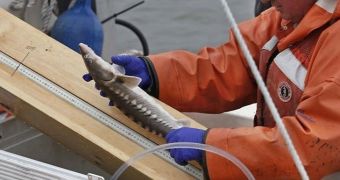There used to be a time when man didn't really think twice about building some new structure in some creature's place of residence, but now the construction of an immense bridge in the New York city suburbs has warranted a study of the fish in the area.
Environmentalists would probably love to claim responsibility for this arguably surprising turn of events, but they can't.
You see, it's not environmental concerns that got biologists to study the impact of the bridge on the aquatic life in the area. Instead, it's the supply of fish and caviar.
Sturgeons from the Hudson River have been valued as food for a long time. Alas, fishing got out of control by the 20th century, forcing all of it to stop in 1996, according to Frances Dunwell, a coordinator with the state Department of Environmental Conservation.
The last time an estimate was made, the sturgeon population was pegged at under 900, although juvenile fish numbers seemed to swell recently.
Alas, the construction of the bridge in suburban New York isn't helping matters. That's why Biologist Chris Burnett and his partner John O'Herron have begun to conduct live surgeries on the fish.
It might sound cruel, but it's actually part of a study to see how the bridge impacted their habitat. And the procedure is as painless as they could make it.
Basically, after reeling in the shortnose sturgeon, they made a 3-inch incision in the belly and inserted an electronic tracking device.
Then, they stitched up the wound and placed the fish in a holding tank to make sure the fish would live without any lasting damage.
When they were reasonably sure that was the case (they used a monitor to ensure that the transmitter worked as well), the 3-pound fish was released back into the river. The chip should be good for a few months of underwater tracking.
Fortunately, the surgery, so to speak, wasn't done without anesthetic. First, the fish was dunked in a tank spiked with a nerve-numbing substance. It made sure the fish wouldn't struggle or suffer too much while being operated on and weighed.
So far, only about half of the intended 120 sturgeons have been tagged this way. The biologists hope that their survey will show the spawn rate to be unaffected by the bridge (currently at 3-5 years) or, at least, that the affected females are migrating from the area.
"They only spawn every 3 to 5 years, so if a female that's ready to spawn is injured or affected in some way or doesn't migrate because of the bridge construction, that could have a significant effect on the overall population," said Philip Musegaas of Riverkeeper, an environmental group that focuses on the Hudson.

 14 DAY TRIAL //
14 DAY TRIAL //